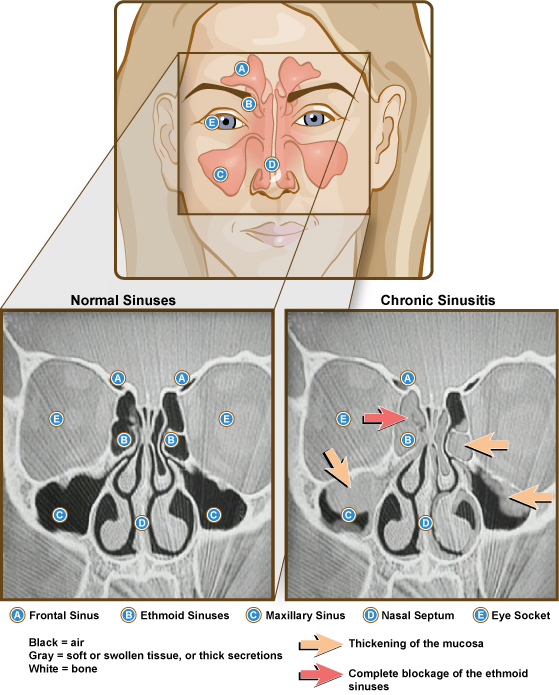
Sinus Disease
According to the CDC, in 2015 roughly 30 million people in the US were diagnosed with sinusitis. This represents roughly 12% of the population. Many things contribute to the development of sinus disease, allergic inflammation, chemical inflammation septal deviation, dilation of the middle turbinate. But as with all diseases, the proper diagnosis of sinus disease should start with a detailed history and a thorough physical exam. This is often supplemented with a procedure called a nasal endoscopy, or the placement of a scope into the nasal cavity to inspect the 1 to 5mm openings of the sinuses. This will reveal pus or polyps or thickened secretions in most patients with true sinus infections or inflammation. Complete evaluation of the extent of sinus disease also requires a radiologic test called a CT scan. This allows for the assessment of the inside of the cavities that make up the sinuses. This may also reveal signs of more dangerous causes of sinus trouble, which may suggest the presence of a sinus cancer or benign mass.Unfortunately, there is no magic bullet for sinus disease. But with the help of Dr York, we can frequently avoid the need for surgical procedures such as balloon sinuplasty or even formal endoscopic sinus surgery. A thorough attempt at medical management should be completed prior to such procedures. Though more aggressive medications are usually prescribed to gain short-term control, long-term control often requires extended treatment with nasal irrigations and nasal steroid spray. For the roughly 40% of patients who fail this first step, an evidence-based surgical procedure can be discussed as the next option in management. There are many offices and corporations that push a single modality of treatment, like a balloon sinuplasty. Dr York very infrequently recommends this technique as most true sinus diseases are not adequately addressed with this very conservative procedure. Dr York reserves balloon sinuplasty for the treatment of true recurrent acute sinusitis and sinus pain felt on flights or changes in altitude.
For patients who require surgical intervention, a functional endoscopic sinus surgery is the usual modality of treatment. This should be performed by a surgeon such as Dr York who've had extensive training in the technique, as rare complications such as a spinal fluid leak and damage to the eye can occur. For extensive or complicated surgeries, Dr York will employ a highly specialized technology which uses your pre-operative CT scan to guide surgery which will increase the safety of your surgery. It allows Dr York to touch a specific location inside the nose, and observe that point on your CT scan.
When considering sinus surgery, it is important to realize the limitations of the surgery itself. While it is quite possible to remove most or all of the polyps, this alone does not fix what is inherently wrong, which is the hyper-reactivity of the skin of the sinuses, which is the reason people develop sinus disease in the first place. In Endoscopic Sinus Surgery, the walls separating the various sinus compartments are completely removed. This results in wide open sinus compartments. This is important for two reasons, the sinuses can then drain freely without the obstruction of the 1 to 5mm openings which were previously present. Perhaps more importantly, the saline from nasal irrigations is then able to flow freely into and out of the sinuses to wash out whichever substance is causing the inflammation. Nasal steroid spray can also then deposit directly into the sinuses to help keep the inflammation reduced and controlled. Despite optimal medical and surgical management, there are subcategories of sinusitis which inevitably result in recurrent polyp growth. In these patients, the goal of treatment should be to reduce the total number of trips to the operating room by adhering to a strict medical regimen involving antibiotics, oral steroids, irrigations, antihistamines, leukotriene inhibitors, and nasal steroid spray.
While expensive mechanical irrigates exist, most patients do just as well with the cheaper irrigation system recommended by Dr York, the Neilmed Sinus Rinse. Click on the link for an instructional video on how to optimally use this product.
If you are suffering from sinus issues, make an appointment with Dr York today, CLICK HERE!
For what to expect after formal endoscopic sinus surgery, CLICK HERE!